Calculation of Stray-Field Loss of TEAM P21 Model Under Complex Excitations Based on the Improved Energetic Hysteresis Model
Abstract
1. Introduction
2. Experimental Platform and Strategy for Determination of Stray Loss
- (1)
- The software Simcenter MAGNETTM is used to model exciting coils (E-coil) with load components, as shown in Figure 2a, which the version of the software is 7.5. Figure 2b shows that the influence of Dcoil on the ohmic loss of the excitation coils (Pcoil). Figure 2 shows the simulated ohmic loss of E-coil when the RMS value of the excitation AC current reaches 10 A.
- (2)
- The distance between the different load components and the windings varies. However, the distance between the compensating coils and the exciting coils is constant (24 mm); a loss coefficient ξDcoil is introduced to take into consideration the loss of the coil varying with Dcoil.where Pload is the ohmic loss under load condition and Pno-load(E+C) is the ohmic loss measured under no-load condition with C-coils.
3. Calculation of Loss of GO and Magnetic Steel Plate Under Complex Excitations
3.1. Energetic Hysteresis Model (EM)
3.2. Improved Energetic Hysteresis Model (IEM)
- (1)
- Shortcomings in MEM
- (2)
- Improved Energetic hysteresis model (IEM)
3.3. Calculation and Verification of Magnetic Loss of GO Under Harmonic Excitations
3.4. Calculation and Verification of Magnetic Loss of GO Under Harmonic and DC Hybrid Excitations
3.5. Calculation Method of Hysteresis Loss of Magnetic Steel Plate Under Complex Excitation Conditions
4. Modeling Method for Stray-Field Loss
4.1. Analysis of Existing Methods of Additional Loss
4.2. Computational Strategy of Stray-Field Loss with Different Types of Load Components
5. Calculation and Verification
6. Conclusions
- (1)
- The distribution of the leakage flux around the coil depends not only on the types of load components, but also on the distance Dcoil between the load components and the coil. The improved method proposed can not only consider the distribution of the leakage flux around the coil, but also consider the influence of the Dcoil on the coil loss, so as to more accurately separate the stray-field loss of load components from the total loss.
- (2)
- By considering the scope of application of equation (k = μ0HCMs) and the effect of magnetization contribution on EM parameters, the IEM is proposed which can not only reduce the dependence on measurement data for calculating model parameters but also successfully improves the accuracy of hysteresis loss and loop compared to the MEM, where the hysteresis loss coefficient k and saturated magnetic field proportion coefficient h are derived theoretically and validated by experiments.
- (3)
- To predict the influence of DC magnetization on the loss, the loss-map, which expresses the magnetic loss under DC bias, is established. Based on the STL, the loss calculation method under sinusoidal, harmonic, and harmonic and DC hybrid excitations is proposed and validated by experiments.
- (4)
- By discussing the advantages and limitations of existing numerical approaches of additional loss, it could be found that the 2-D eddy current region is only applicable to the case in which the eddy current skin phenomenon can be completely ignored. Considering the influence of the eddy current field modeling method on the stray-field loss computational strategy, the stray-field loss calculation method of GO, magnetic steel plate, and combined components of both materials under complex excitations is established. The effectiveness of the stray loss calculation method is verified by comparing the stray-field loss and leakage magnetic field experimental results with the simulation results.
- (5)
- The proposed method can be used to calculate transformer stray losses, offering theoretical support for transformer design. This approach addresses both the reliability and high efficiency needs of transformers, providing a theoretical foundation for modeling the electromagnetic thermal optimization constraints of transformers.
Author Contributions
Funding
Data Availability Statement
Conflicts of Interest
References
- Schäfer, J.; Rohner, G.; Kolar, J.W. Extending the Steinmetz Equation: Incorporating Mechanical Stress Effects in Ferrite Core Loss Calculations. IEEE Open J. Power Electron. 2025, 6, 56–65. [Google Scholar] [CrossRef]
- Gömöry, F.; Šouc, J.; Solovyov, M.; Ries, R.; Hintze, C.; Landvogt, S.; Pekarčíková, M.; Christensen, J.J.; Bahl, C.R.; Jørgensen, N.O.; et al. Hysteresis and Coupling Loss in Filamentized REBCO Tapes. IEEE Trans. Appl. Supercond. 2025, 35, 5900205. [Google Scholar] [CrossRef]
- Kwon, J.; Sa, J.; Lee, S.; Jang, G. A Voltage Minimization Control Method for Magnetic Navigation Systems to Enhance the Rotating Magnetic Field. IEEE Robot. Autom. Lett. 2024, 9, 11561–11568. [Google Scholar] [CrossRef]
- Sato, H.; Kotani, J.; Sasaki, Y.; Tomioka, S.; Takizawa, T.; Ueda, Y.; Kimiya, H.; Igarashi, H. Analysis of Magnetic Properties of Soft Magnetic Composite Using Magnetic Circuits Generated by Discrete Element Method. IEEE Trans. Magn. 2024, 60, 7402807. [Google Scholar] [CrossRef]
- Li, C.; Cheng, M.; Qin, W.; Wang, Z.; Ma, X.; Wang, W. Analytical Loss Model for Magnetic Cores Based on Vector Magnetic Circuit Theory. IEEE Open J. Power Electron. 2024, 5, 1659–1670. [Google Scholar] [CrossRef]
- Hossain, M.S.; Islam, M.R.; Sutanto, D.; Muttaqi, K.M. Advanced Soft Magnetic Materials for the Development of High-Frequency Magnetic Core Used in Solid-State Transformers. IEEE Trans. Appl. Supercond. 2024, 34, 5501105. [Google Scholar] [CrossRef]
- Li, Y.; Li, Y.; Lin, Z.; Yue, S.; Chen, R.; Guo, P.; Liu, J. A Hysteresis Model for Soft Magnetic Composites Considering Particle Size Distribution. IEEE Trans. Magn. 2024, 60, 7301405. [Google Scholar] [CrossRef]
- Kanakgiri, K.; Bhardwaj, D.I.; Ram, B.S.; Kulkarni, S.V. A Circuit-Based Formulation for Soft Magnetic Materials Using the Jiles–Atherton Model. IEEE Trans. Magn. 2024, 60, 7301107. [Google Scholar] [CrossRef]
- Zhao, X.; Cao, Y.; Cheng, Z.; Forghani, B.; Liu, L.; Wang, J. Experimental and numerical study on stray loss in laminated magnetic shielding under 3-D AC-DC hybrid excitations for HVDC transformers. IEEE Access 2020, 8, 144432–144441. [Google Scholar] [CrossRef]
- Wang, J.; Dagan, K.J.; Yuan, X.; Wang, W.; Mellor, P.H. A practical approach for core loss estimation of a high-current gapped inductor in PWM converters with a user-friendly loss map. IEEE Trans. Power Electron. 2019, 34, 5697–5710. [Google Scholar] [CrossRef]
- Steinmetz, C.P. On the law of hysteresis. Proc. IEEE 1984, 72, 197–221. [Google Scholar] [CrossRef]
- Reinert, J.; Brockmeyer, A.; De Doncker, R.W.A.A. Calculation of losses in ferro- and ferrimagnetic materials based on the modified Steinmetz equation. IEEE Trans. Ind. Appl. 2001, 37, 1055–1061. [Google Scholar] [CrossRef]
- Li, J.; Abdallah, T.; Sullivan, C.R. Improved calculation of core loss with nonsinusoidal waveforms. In Proceedings of the Conference Record of the 2001 IEEE Industry Applications Conference. 36th IAS Annual Meeting (Cat. No.01CH37248), Chicago, IL, USA, 30 September–4 October 2001; pp. 2203–2210. [Google Scholar]
- Mulethaler, J.; Biela, J.; Kolar, J.W.; Ecklebe, A. Improved core loss calculation for magnetic components employed in power electronic systems. IEEE Trans. Power Electron. 2012, 27, 964–973. [Google Scholar] [CrossRef]
- Shen, W.; Wang, F.; Boroyevic, D.; Tipton, C.W. Loss characterization and calculation of nanocrystalline cores for high-frequency applications. IEEE Trans. Power Electron. 2008, 23, 475–484. [Google Scholar] [CrossRef]
- Barg, S.; Ammous, K.; Mejbri, H.; Ammous, A. An improved empirical formulation for magnetic core losses estimation under nonsinusoidal induction. IEEE Trans. Power Electron. 2017, 32, 2146–2154. [Google Scholar] [CrossRef]
- Novak, G.; Kokošar, J.; Nagode, A.; Petrovič, D.S. Core-loss prediction for non-oriented electrical steels based on the steinmetz equation using fixed coefficients with a wide frequency range of validity. IEEE Trans. Magn. 2015, 51, 2001507. [Google Scholar] [CrossRef]
- Bertotti, G.; Fiorillo, F.; Soardo, G.P. The prediction of power losses in soft magnetic materials. Le J. Phys. Colloq. 1988, 49, 1915–1919. [Google Scholar] [CrossRef]
- Fiorillo, F.; Novikov, A. An improved approach to power losses in magnetic laminations under nonsinusoidal induction waveform. IEEE Trans. Magn. 1990, 26, 2904–2910. [Google Scholar] [CrossRef]
- Eggers, D.; Steentjes, S.; Hameyer, K. Advanced iron-loss estimation for nonlinear material behavior. IEEE Trans. Magn. 2012, 48, 3021–3024. [Google Scholar] [CrossRef]
- Liu, R.; Li, L. Analytical prediction model of energy losses in soft magnetic materials over broadband frequency range. IEEE Trans. Power Electron. 2021, 36, 2009–2017. [Google Scholar] [CrossRef]
- Zhao, H.; Ragusa, C.; Appino, C.; Barrière, O.; Wang, Y.; Fiorillo, F. Energy losses in soft magnetic materials under symmetric and asymmetric induction waveforms. IEEE Trans. Power Electron. 2019, 34, 2655–2665. [Google Scholar] [CrossRef]
- Zhao, Z.; Hu, X. Modified loss separation in FeSi laminations under arbitrary distorted flux. AIP Adv. 2020, 10, 085222. [Google Scholar] [CrossRef]
- Lavers, J.; Biringer, P.; Hollitscher, H. A simple method of estimating the minor loop hysteresis loss in thin laminations. IEEE Trans. Magn. 1978, 14, 386–388. [Google Scholar] [CrossRef]
- Jiles, D.C.; Thoelke, J.B.; Devine, M.K. Numerical determination of hysteresis parameters for the modeling of magnetic properties using the theory of ferromagnetic hysteresis. IEEE Trans. Magn. 1992, 28, 27–35. [Google Scholar] [CrossRef]
- Dlala, E. Efficient algorithms for the inclusion of the preisach hysteresis model in nonlinear finite-element methods. IEEE Trans. Magn. 2011, 47, 395–408. [Google Scholar] [CrossRef]
- Hauser, H. Energetic model of ferromagnetic hysteresis: Isotropic magnetization. J. Appl. Phys. 2004, 96, 2753–2767. [Google Scholar] [CrossRef]
- Li, Y.; Zhu, J.; Zhu, L.; Li, Y.; Lei, G. A dynamic magnetostriction model of grain-oriented sheet steels based on Becker–Döring crystal magnetization model and Jiles-Atherton theory of magnetic hysteresis. IEEE Trans. Magn. 2020, 56, 7511405. [Google Scholar] [CrossRef]
- Liu, R.; Li, L. Accurate symmetrical minor loops calculation with a modified energetic hysteresis model. IEEE Trans. Magn. 2020, 56, 7510204. [Google Scholar] [CrossRef]
- Takahashi, N.; Sakura, T.; Cheng, Z. Nonlinear analysis of eddy current and hysteresis losses of 3-D stray field loss model (Problem 21). IEEE Trans. Magn. 2001, 37, 3672–3675. [Google Scholar] [CrossRef]
- Cheng, Z.; Forghani, B.; Du, Z.; Liu, L.; Li, Y.; Zhao, X.; Liu, T.; Cai, L.; Zhang, W.; Lu, M.; et al. Modeling and validation of stray-field loss inside magnetic and non-magnetic components under harmonics-DC hybrid excitations based on updated TEAM Problem 21. COMPEL 2021, 40, 941–960. [Google Scholar] [CrossRef]
- Zirka, S.E.; Moroz, Y.I.; Steentjes, S.; Hameyer, K.; Chwastek, K.; Zurek, S.; Harrison, R. Dynamic magnetization models for soft ferromagnetic materials with coarse and fine domain structures. J. Magn. Magn. Mater. 2015, 394, 229–236. [Google Scholar] [CrossRef]
- Bertotti, G. Hysteresis in Magnetism for Physicists, Materials Scientists, and Engineers; Academic Press: San Diego, CA, USA; London, UK; Boston, MA, USA; New York, NY, USA; Sydney, Australia; Tokyo, Japan; Toronto, ON, Canada, 1998. [Google Scholar]
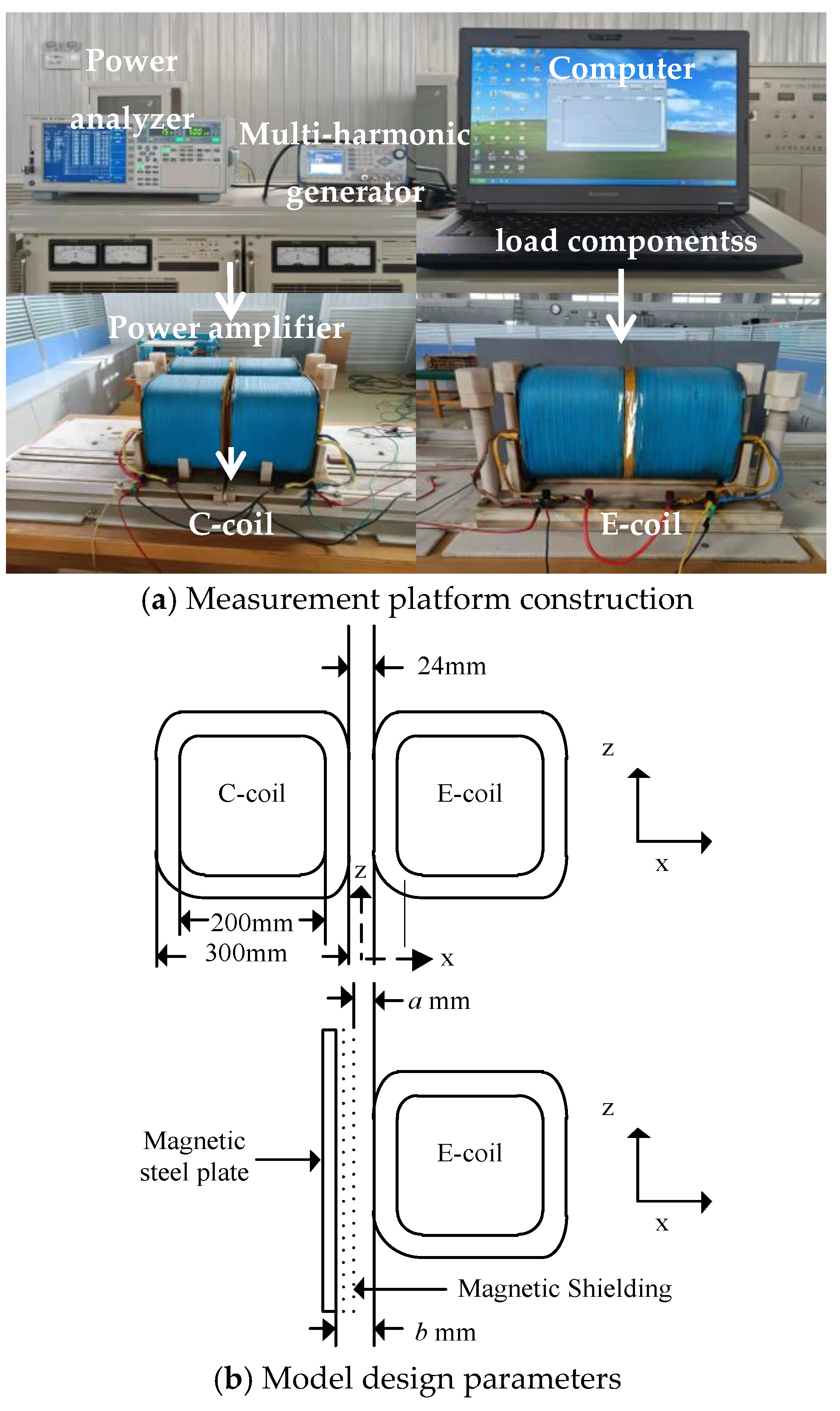
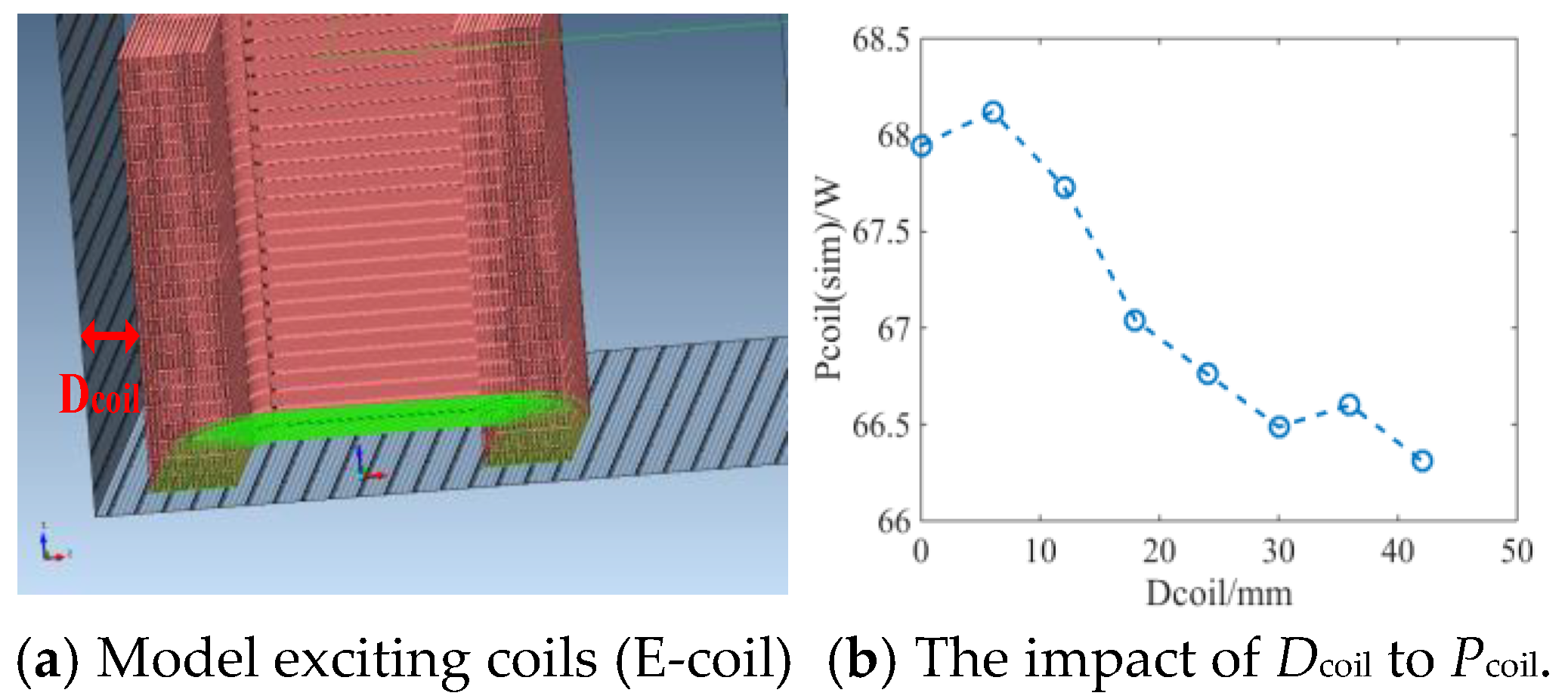

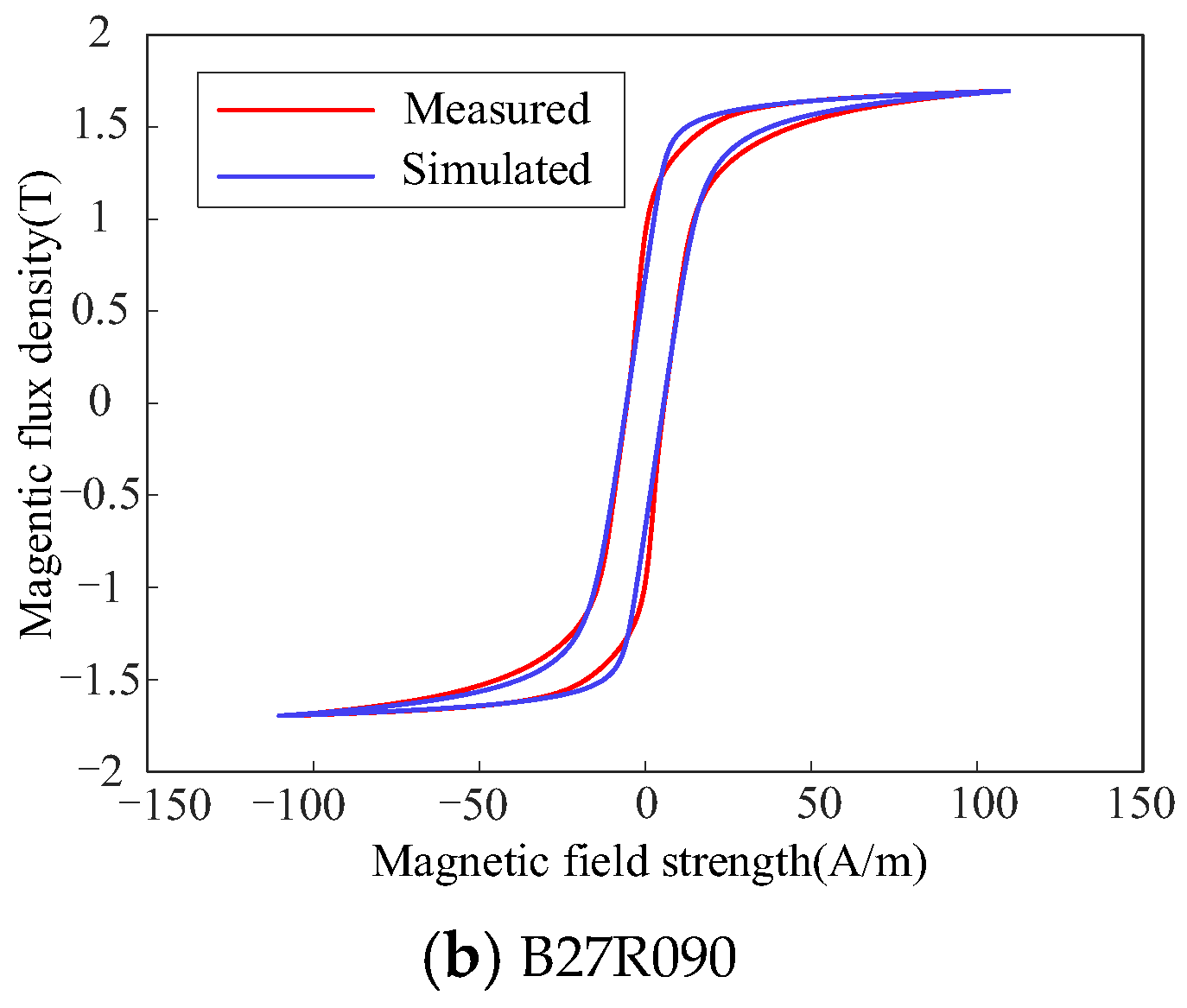
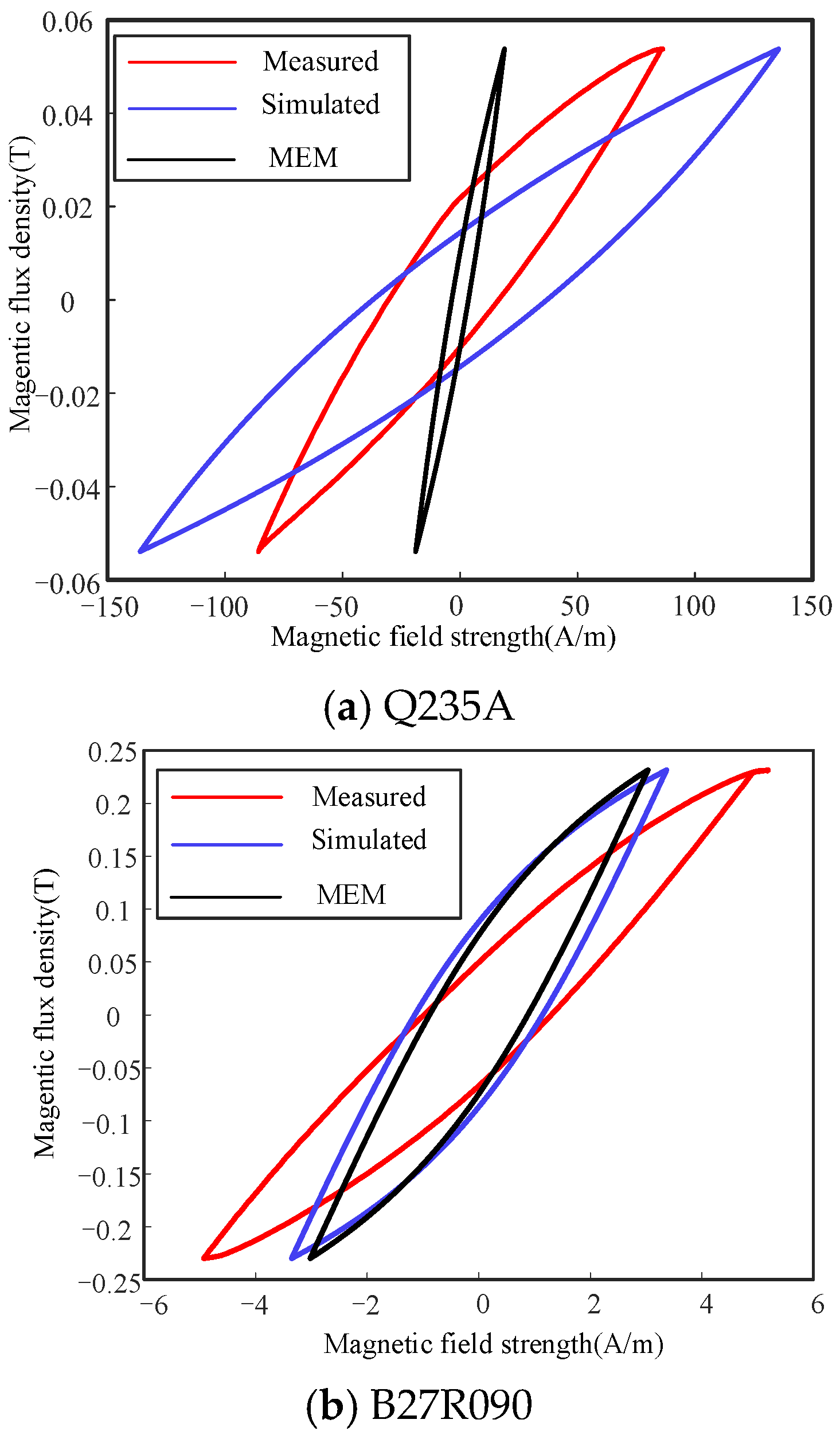
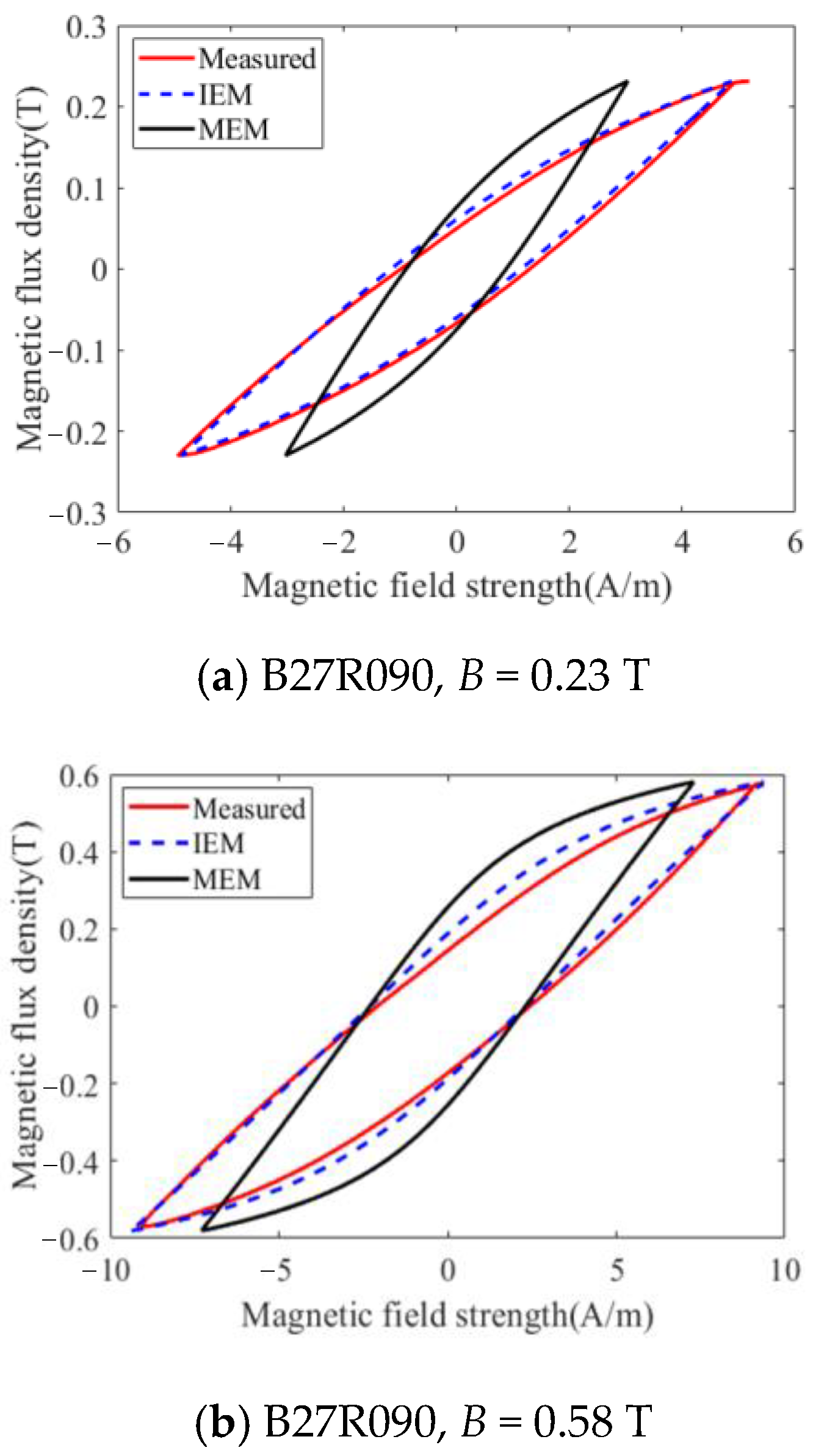
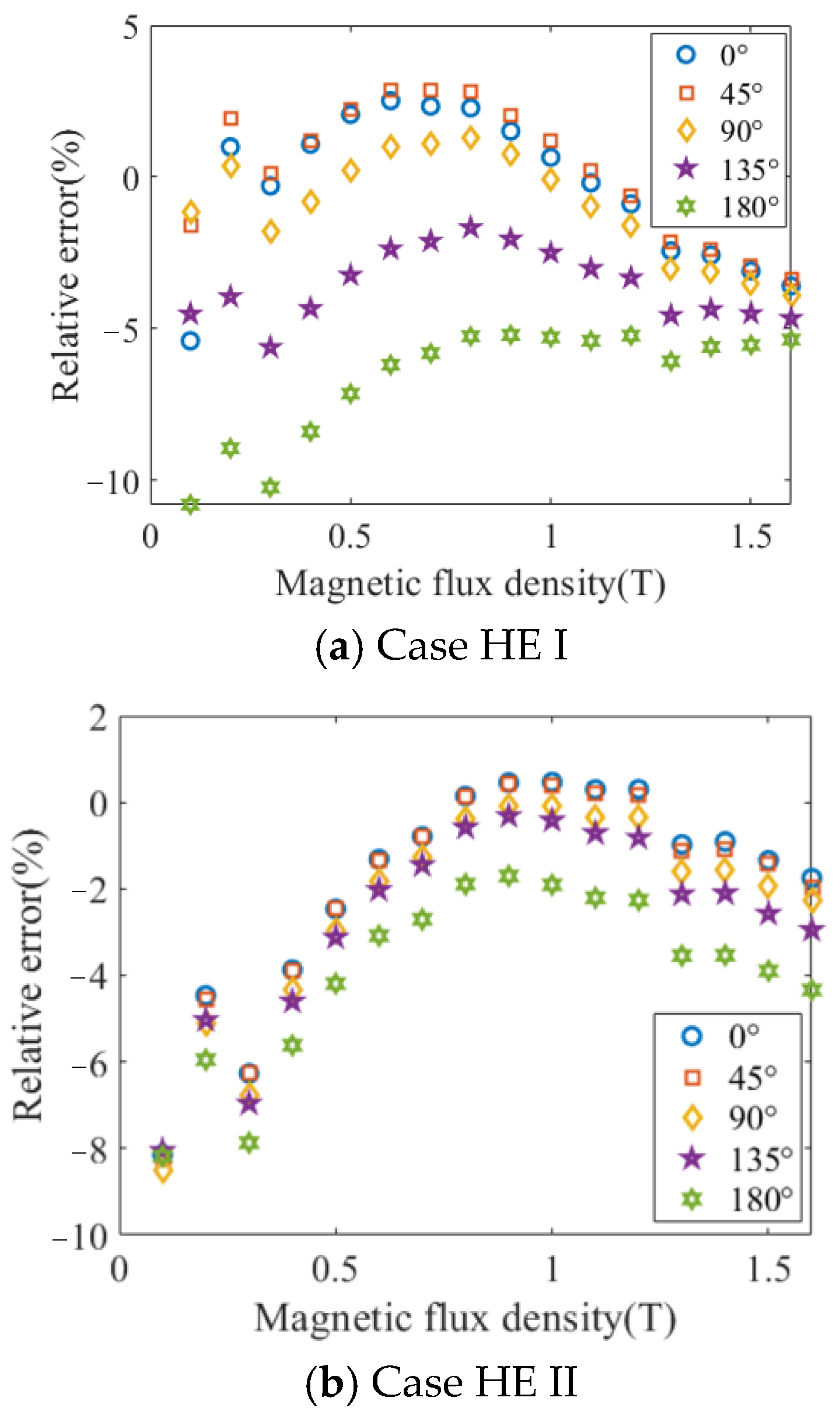
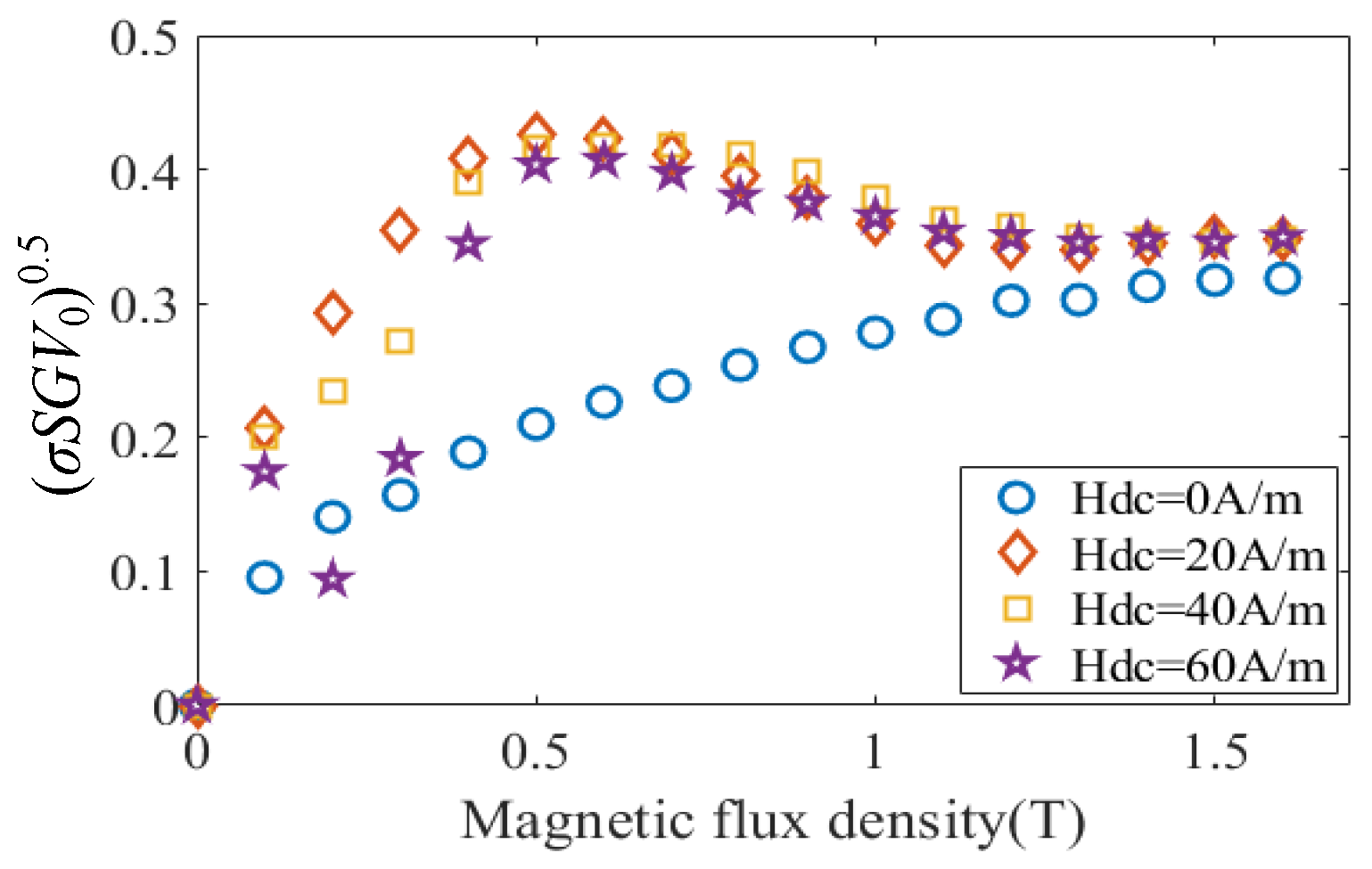

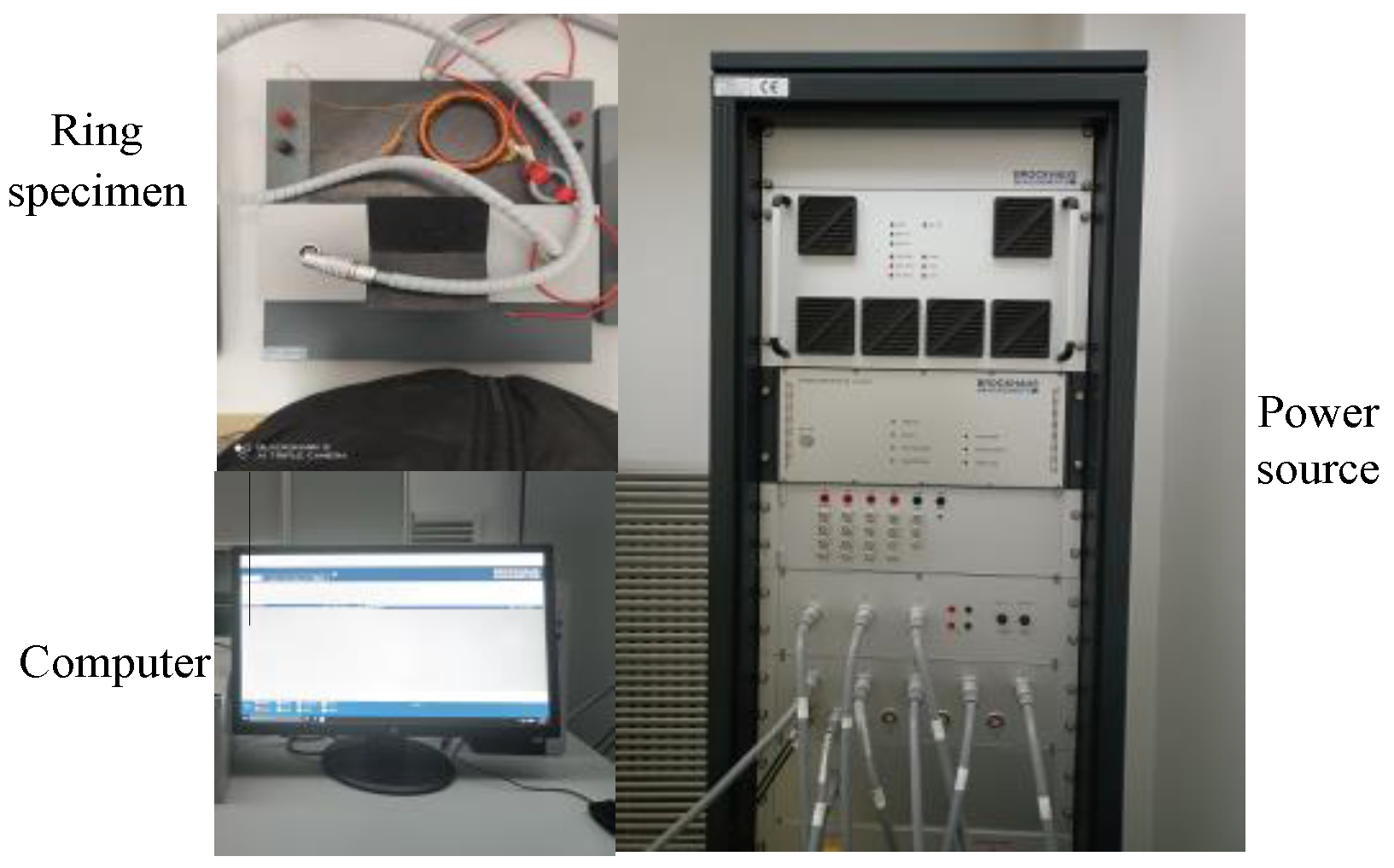
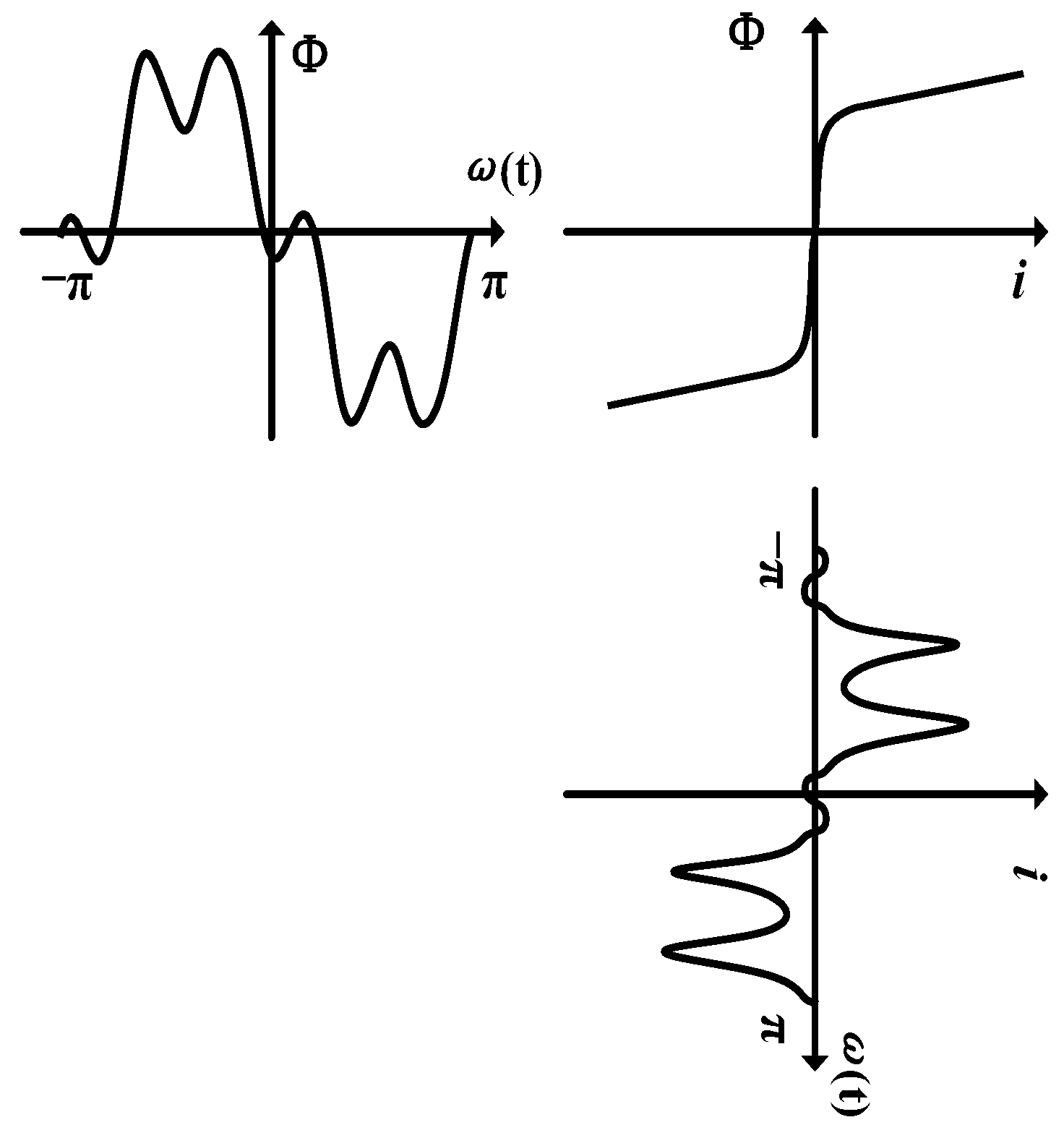
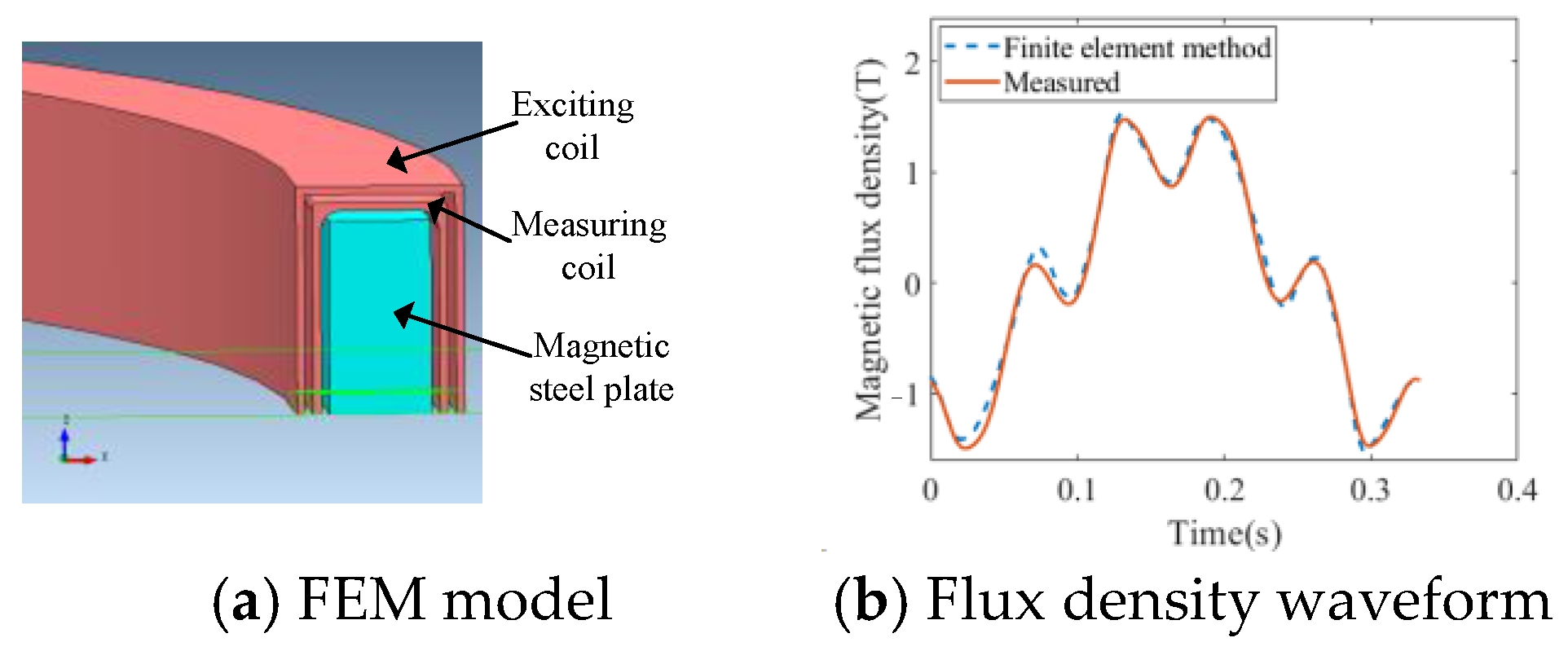

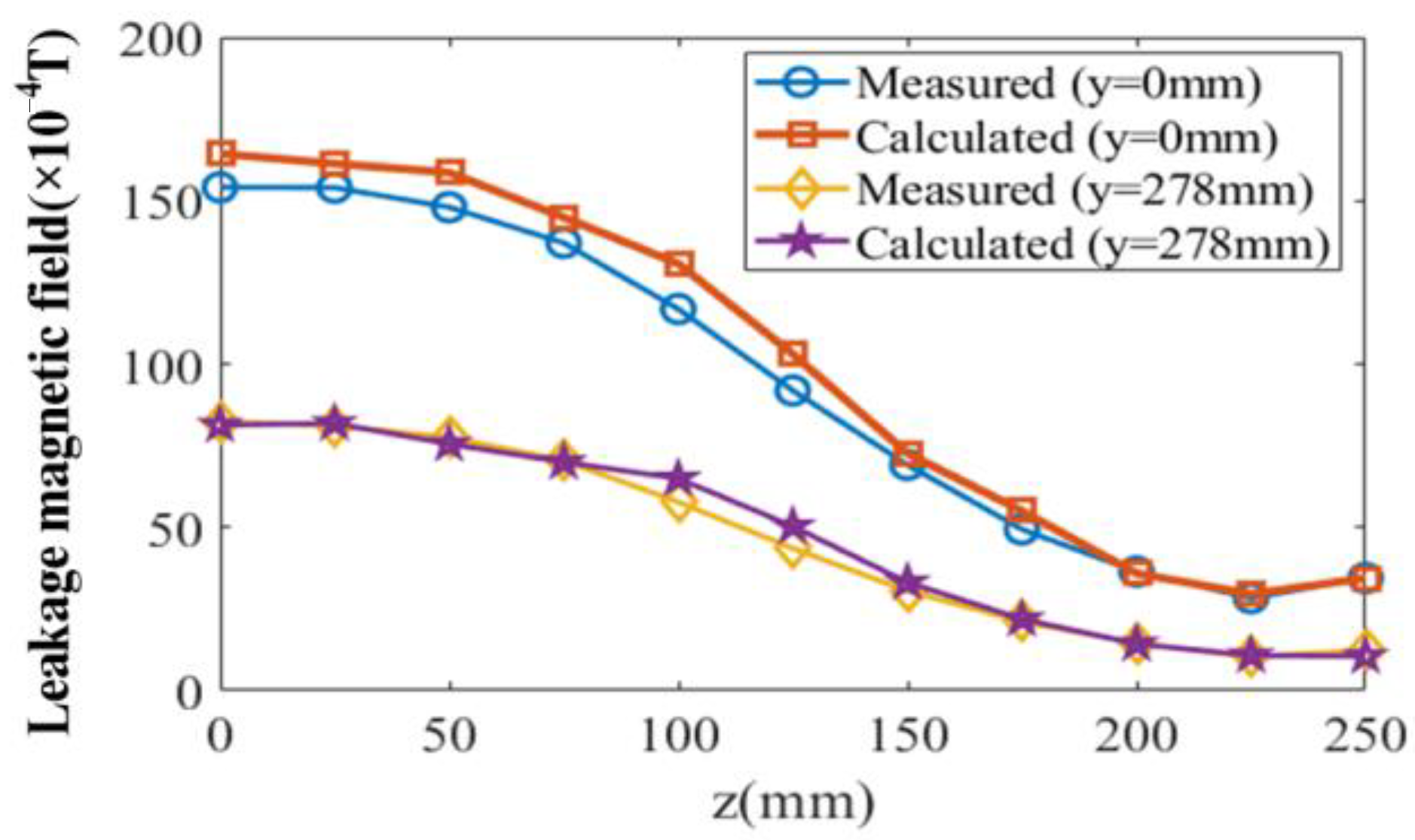
| Cases | Excitation Conditions | |
|---|---|---|
| I | U1sin(ωt) | In each case, the excitation current (AC) reaches 10 A (rms), but without DC component. |
| II | U1sin(ωt) + 0.3U1sin(3ωt) | |
| III | U1sin(ωt) + 0.3U1sin(3ωt) + 0.3U1sin(5ωt) + 0.3U1sin(7ωt) | |
| IV | U1sin(ωt) + 0.3U1sin(3ωt) (with DC component) | Hybrid excitation at the same side of model’s part; AC reaches 7 A (rms) and includes DC (5 A). |
| Cases | GO/(W) | Magnetic Steel Plate/(W) | Combined Components/(W) |
|---|---|---|---|
| I | 5.77 | 28.36 | 5.16 |
| II | 6.39 | 30.51 | 5.90 |
| III | 7.46 | 32.48 | 7.03 |
| IV | 2.80 | 15.94 | 2.92 |
| Ms (×106 A/m) | Ne (×10−5) | h (A/m) | g | q | cr | |
|---|---|---|---|---|---|---|
| Q235A | 1.55 | 14.71 | 56.80 | 10.06 | 32.57 | 0.27 |
| B27R090 | 1.55 | 1.03 | 0.14 | 12.82 | 35.95 | 0.92 |
| Ne ↑ | h ↑ | g ↑ | q ↑ | cr ↑ | k ↑ | |
|---|---|---|---|---|---|---|
| Br | ↓ | ↓ | ↓ | ↑ | ↑ | ↑ |
| Hc | --- | --- | --- | ↑ | --- | ↑ |
| Hmax | ↑ | ↑ | ↑ | ↑ | ↑ | ↑ |
| Loop area | --- | ↑ | ↑ | ↑ | ↑ | ↑ |
| B (T) | B27R090 | ||
|---|---|---|---|
| Whys(mea) | δ1(IEM) (%) | δ1(MEM) (%) | |
| 0.11 T | 17.12 | 5.08 | −85.11 |
| 0.18 T | 44.40 | −0.38 | −41.61 |
| 0.23 T | 65.43 | −0.62 | −29.18 |
| 0.28 T | 94.14 | −0.96 | −19.73 |
| 0.34 T | 124.20 | 4.14 | −8.24 |
| 0.38 T | 155.19 | 0.11 | −8.41 |
| 0.42 T | 189.50 | 0.13 | −5.61 |
| Cases | Excitation Conditions | |
|---|---|---|
| HE I | U1 sin (ωt) + 0.9U1 sin (3ωt + θ) | θ = 0°, 45°, 90°, 135°, 180° |
| HE II | U1 sin (ωt) + 1.5U1 sin (5ωt + θ) | θ = 0°, 45°, 90°, 135°, 180° |
| Cases | Excitation Conditions | |
|---|---|---|
| H + DC E I | U1 sin (ωt) + 0.9U1 sin (3ωt + θ) + Idc | θ = 0°, 90°, 180°. Hdc = 20, 40, 60 A/m |
| H + DC E II | U1 sin (ωt) + 1.5U1 sin (5ωt + θ) + Idc | θ = 0°, 90°, 180° Hdc = 20, 40, 60 A/m |
| Turns of Ring Specimen | Outer Diameter (mm) | Inner Diameter (mm) | Height (mm) | Conductivity (S/m) |
|---|---|---|---|---|
| 1800 | 95 | 100 | 9.5 | 6484,000 |
| Cases | Excitation Conditions | |
|---|---|---|
| H E | U1 sin (ωt) + 1.5U1 sin (5ωt + θ) | θ = 0°, 90°, 180° |
| Cases | GO/(W) | Magnetic Steel Plate/(W) | Combined Components/(W) | |||
|---|---|---|---|---|---|---|
| Mea | Cal | Mea | Cal | Mea | Cal | |
| I | 5.77 | 5.54 | 28.36 | 27.69 | 5.16 | 5.37 |
| II | 6.39 | 6.11 | 30.51 | 30.03 | 5.90 | 5.73 |
| III | 7.46 | 6.91 | 32.48 | 32.43 | 7.03 | 6.79 |
| IV | 2.80 | 2.60 | 15.94 | 15.04 | 2.92 | 2.67 |
Disclaimer/Publisher’s Note: The statements, opinions and data contained in all publications are solely those of the individual author(s) and contributor(s) and not of MDPI and/or the editor(s). MDPI and/or the editor(s) disclaim responsibility for any injury to people or property resulting from any ideas, methods, instructions or products referred to in the content. |
© 2025 by the authors. Licensee MDPI, Basel, Switzerland. This article is an open access article distributed under the terms and conditions of the Creative Commons Attribution (CC BY) license (https://creativecommons.org/licenses/by/4.0/).
Share and Cite
Zhao, Z.; Li, D. Calculation of Stray-Field Loss of TEAM P21 Model Under Complex Excitations Based on the Improved Energetic Hysteresis Model. Symmetry 2025, 17, 189. https://doi.org/10.3390/sym17020189
Zhao Z, Li D. Calculation of Stray-Field Loss of TEAM P21 Model Under Complex Excitations Based on the Improved Energetic Hysteresis Model. Symmetry. 2025; 17(2):189. https://doi.org/10.3390/sym17020189
Chicago/Turabian StyleZhao, Zhigang, and Dehai Li. 2025. "Calculation of Stray-Field Loss of TEAM P21 Model Under Complex Excitations Based on the Improved Energetic Hysteresis Model" Symmetry 17, no. 2: 189. https://doi.org/10.3390/sym17020189
APA StyleZhao, Z., & Li, D. (2025). Calculation of Stray-Field Loss of TEAM P21 Model Under Complex Excitations Based on the Improved Energetic Hysteresis Model. Symmetry, 17(2), 189. https://doi.org/10.3390/sym17020189




